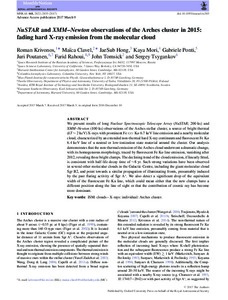NuSTAR and XMM-Newton observations of the Arches cluster in 2015: fading hard X-ray emission from the molecular cloud
Krivonos R; Clavel M; Hong J; Mori K; Ponti G; Poutanen J; Rahoui F; Tomsick J; Tsygankov S
NuSTAR and XMM-Newton observations of the Arches cluster in 2015: fading hard X-ray emission from the molecular cloud
Krivonos R
Clavel M
Hong J
Mori K
Ponti G
Poutanen J
Rahoui F
Tomsick J
Tsygankov S
OXFORD UNIV PRESS
Julkaisun pysyvä osoite on:
https://urn.fi/URN:NBN:fi-fe2021042716898
https://urn.fi/URN:NBN:fi-fe2021042716898
Tiivistelmä
We present results of long Nuclear Spectroscopic Telescope Array (NuSTAR; 200 ks) and XMM-Newton (100 ks) observations of the Arches stellar cluster, a source of bright thermal (kT similar to 2 keV) X-rays with prominent Fe XXV K alpha 6.7 keV line emission and a nearby molecular cloud, characterized by an extended non-thermal hard X-ray continuum and fluorescent Fe K alpha 6.4 keV line of a neutral or low-ionization state material around the cluster. Our analysis demonstrates that the non-thermal emission of the Arches cloud underwent a dramatic change, with its homogeneous morphology, traced by fluorescent Fe K alpha line emission, vanishing after 2012, revealing three bright clumps. The declining trend of the cloud emission, if linearly fitted, is consistent with half-life decay time of similar to 8 yr. Such strong variations have been observed in several other molecular clouds in the Galactic Centre, including the giant molecular cloud Sgr B2, and point towards a similar propagation of illuminating fronts, presumably induced by the past flaring activity of Sgr A(star). We also detect a significant drop of the equivalent width of the fluorescent Fe Ka line, which could mean either that the new clumps have a different position along the line of sight or that the contribution of cosmic ray has become more dominant.
Kokoelmat
- Rinnakkaistallenteet [27094]
